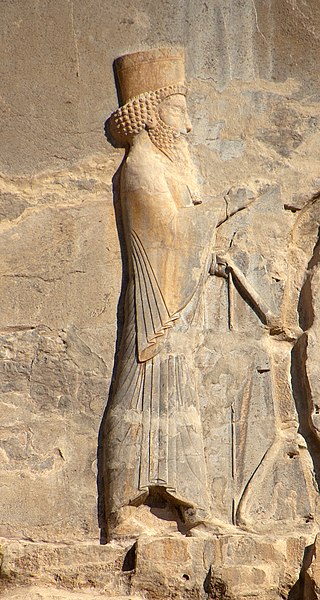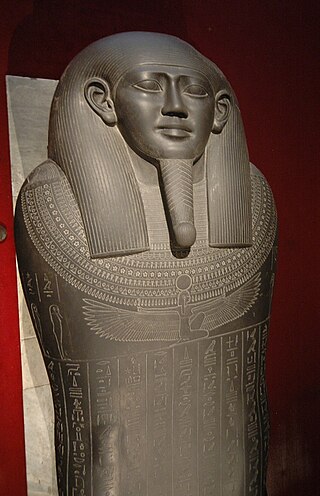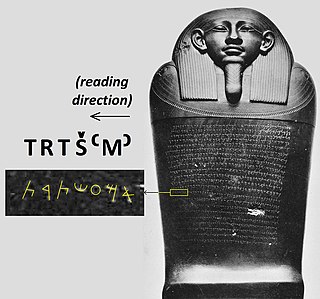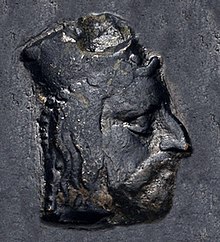
Arses, known by his regnal name Artaxerxes II, was King of Kings of the Achaemenid Empire from 405/4 BC to 358 BC. He was the son and successor of Darius II and his mother was Parysatis.

Ochus, known by his dynastic name Artaxerxes III, was King of Kings of the Achaemenid Empire from 359/58 to 338 BC. He was the son and successor of Artaxerxes II and his mother was Stateira.

The sarcophagus ofEshmunazar II is a 6th-century BC sarcophagus unearthed in 1855 in the grounds of an ancient necropolis southeast of the city of Sidon, in modern-day Lebanon, that contained the body of Eshmunazar II, Phoenician King of Sidon. One of only three Ancient Egyptian sarcophagi found outside Egypt, with the other two belonging to Eshmunazar's father King Tabnit and to a woman, possibly Eshmunazar's mother Queen Amoashtart, it was likely carved in Egypt from local amphibolite, and captured as booty by the Sidonians during their participation in Cambyses II's conquest of Egypt in 525 BC. The sarcophagus has two sets of Phoenician inscriptions, one on its lid and a partial copy of it on the sarcophagus trough, around the curvature of the head. The lid inscription was of great significance upon its discovery as it was the first Phoenician language inscription to be discovered in Phoenicia proper and the most detailed Phoenician text ever found anywhere up to that point, and is today the second longest extant Phoenician inscription, after the Karatepe bilingual.

The ancient history of Cyprus shows a precocious sophistication in the Neolithic era visible in settlements such as at Choirokoitia dating from the 9th millennium BC, and at Kalavassos from about 7500 BC.

The Temple of Eshmun is an ancient place of worship dedicated to Eshmun, the Phoenician god of healing. It is located near the Awali river, 2 kilometres (1.2 mi) northeast of Sidon in southwestern Lebanon. The site was occupied from the 7th century BC to the 8th century AD, suggesting an integrated relationship with the nearby city of Sidon. Although originally constructed by Sidonian king Eshmunazar II in the Achaemenid era to celebrate the city's recovered wealth and stature, the temple complex was greatly expanded by Bodashtart, Yatonmilk and later monarchs. Because the continued expansion spanned many centuries of alternating independence and foreign hegemony, the sanctuary features a wealth of different architectural and decorative styles and influences.

Eshmunazar II was the Phoenician king of Sidon. He was the grandson of Eshmunazar I, and a vassal king of the Persian Achaemenid Empire. Eshmunazar II succeeded his father Tabnit I who ruled for a short time and died before the birth of his son. Tabnit I was succeeded by his sister-wife Amoashtart who ruled alone until Eshmunazar II's birth, and then acted as his regent until the time he would have reached majority. Eshmunazar II died prematurely at the age of 14. He was succeeded by his cousin Bodashtart.

Bodashtart was a Phoenician ruler, who reigned as King of Sidon, the grandson of King Eshmunazar I, and a vassal of the Achaemenid Empire. He succeeded his cousin Eshmunazar II to the throne of Sidon, and scholars believe that he was succeeded by his son and proclaimed heir Yatonmilk.

Phoenicia, or Phœnicia, was an ancient Semitic thalassocratic civilization originating in the coastal strip of the Levant region of the eastern Mediterranean, primarily located in modern Lebanon. The territory of the Phoenicians extended and shrank throughout history, with the core of their culture stretching from Arwad in modern Syria to Mount Carmel in modern Israel, covering the entire coast of modern Lebanon. Beyond their homeland, the Phoenicians extended through trade and colonization throughout the Mediterranean, from Cyprus to the Iberian Peninsula.

Tabnit was the Phoenician King of Sidon c. 549–539 BC. He was the father of King Eshmunazar II.
Philocles was King of Sidon and a military commander under the Ptolemaic dynasty in the late 4th and early 3rd century BC, and one of the architects of Ptolemaic imperialism in the coasts of Asia Minor and the Aegean Sea. He served as an admiral in the Ptolemaic navy during the Second Syrian War.

Tennes was a King of Sidon under the Achaemenid Empire, who ruled the Phoenician city-state of Sidon from, having been associated in power by his father since the 380s. It remains uncertain whether his known heir and successor, Tennes, was his son or some other close relative. His predecessor was Abdashtart I, the son of Baalshillem II

The first Achaemenid conquest of Egypt took place in 525 BCE, leading to the foundation of the Twenty-seventh Dynasty of Egypt, also known as the "First Egyptian Satrapy". Egypt thus became a province (satrapy) of the Achaemenid Persian Empire until 404 BCE while still maintaining Egyptian royalty customs and positions. The conquest was led by Cambyses II, the King of Persia, who defeated the Egyptians at the Battle of Pelusium, and crowned himself as Pharaoh of Egypt. Achaemenid rule was disestablished upon the rebellion and crowning of Amyrtaeus as Pharaoh. A second period of Achaemenid rule in Egypt occurred under the Thirty-first Dynasty of Egypt.
Yatonmilk was a Phoenician King of Sidon, and a vassal to the Achaemenid king of kings Darius I.

The Baalshillem Temple Boy, or Ba'al Sillem Temple Boy, is a votive statue of a "temple boy" with a Phoenician inscription known as KAI 281. It was found along with a number of other votive statues of children near the canal in the Temple of Eshmun in 1963-64 by Maurice Dunand, and is currently in the National Museum of Beirut.
Phoenicia was an ancient Semitic-speaking thalassocratic civilization that originated in the Levant region of the eastern Mediterranean, primarily modern Lebanon. At its height between 1100 and 200 BC, Phoenician civilization spread across the Mediterranean, from Cyprus to the Iberian Peninsula.
Eshmunazar I was a priest of Astarte and the Phoenician King of Sidon. He was the founder of his namesake dynasty, and a vassal king of the Achaemenid Empire. Eshmunazar participated in the Neo-Babylonian campaigns against Egypt under the command of either Nebuchadnezzar II or Nabonidus. The Sidonian king is mentioned in the funerary inscriptions engraved on the royal sarcophagi of his son Tabnit I and his grandson Eshmunazar II. The monarch's name is also attested in the dedicatory temple inscriptions of his other grandson, King Bodashtart.

Baalshillem I was a Phoenician King of Sidon, and a vassal of the Achaemenid Empire. He was succeeded by his son Abdamon to the throne of Sidon.
Baalshillem II was a Phoenician King of Sidon, and the great-grandson of Baalshillem I who founded the namesake dynasty. He succeeded Baana to the throne of Sidon, and was succeeded by his son Abdashtart I. The name Baalshillem means "recompense of Baal" in Phoenician.

Amoashtart was a Phoenician queen of Sidon during the Persian period. She was the daughter of Eshmunazar I, and the wife of her brother, Tabnit. When Tabnit died, Amoashtart became co-regent to her then-infant son, Eshmunazar II, but after the boy died "in his fourteenth year", she was succeeded by her nephew Bodashtart, possibly in a palace coup. Modern historians have characterized her as an "energetic, responsible [woman], and endowed with immense political acumen, [who] exercised royal functions for many years".
Abdamon (also transliterated Abdamun ; Phoenician: 𐤏𐤁𐤃𐤀𐤌𐤍, was a Phoenician King of Sidon, and a vassal of the Achaemenid Empire. He was succeeded by his son Baana to the throne of Sidon.



















